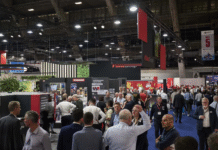Digital printing, more sustainable processes, automation, and added value solutions will be the primary pillars on which Comexi activity is focused at the 2022 K trade fair; the event will be held from the 19th to 26th of October at the Messe in Düsseldorf (Germany). From Hall 4, Stand B31, Comexi will publicly present the new Digiflex. This machine allows the company to currently offer the best digital printing of variable data, such as Datamatrix variable codes, QR codes, barcodes, alphanumeric text, as well as other numbering and marking applications with high quality requirements.
Sustainability, at the Heart of All Innovations
Sustainability, defined as the management of resources to satisfy current needs without jeopardizing future needs, has become a primary global concern in recent years. Consumers are increasingly aware of the environment and do not hesitate to buy sustainable products.
Comexi has always distinguished itself by searching for more innovative sustainable solutions in flexible packaging with a lower carbon footprint: efficient energy management, less material loss, lower ink consumption, as well as reduction of plastic usage and solvents. “At Comexi we are leaders in offering sustainable solutions for printing and converting plastic, and paper packaging. Our goal is to provide products and services that help converters offer added value solutions to their customers. For this reason, in regard to equipment that adapts to the current market needs and requirements, we innovate with consistency,” explains Enric Carrera, the Chief Commercial Officer of Comexi.
As a participant in K, the world’s largest trade fair for the plastics and rubber industry, Comexi will have the opportunity to introduce attendees to the manner by which it applies considerably sustainable processes with solvent-free inks in offset and flexo presses, including options such as WB (water-based) and EB printing.
Additionally, and answering the sustainability claim, water-based coatings are becoming extremely popular for the incoming packaging structures. “We are supplying unique solutions for water-based coatings applications onto paper and film, that are significantly reducing the environmental impact,” says Albert Chicote, the Lamination Business Unit Director of Comexi.
Moreover, Comexi has a strong focus on the automation during the laminating process, for this reason they will show what it has become the most awarded and advanced technology since years in the solventless machinery, the Closed-Loop system, that along with Synaptik Group, provides the highest reliability of the coating weight during a job run without any human intervention.
Automation and Added Value Solutions
Comexi provides “the most sophisticated slitting and rewinding machines, researching and innovating constantly until we satisfy the most demanding needs of our clients and end consumers. We offer various in-line value-added processes associated with these machines, such as in line laser and reel handling solutions”.
Comexi Laser is the revolution of the flexible packaging industry. A laser-in-line processing system can be integrated into Comexi slitting machines. It is the key differentiating technology that optimizes production and follows the most recent technology developments and market trends. Control, precision, and speed can best define this innovative tool, which permits customization, differentiation, and simultaneously, performs a wide range of applications and finishings.
The company Comexi offers the possibility of automating every operation that occurs after rewinding and slitting, such as transport, labelling, weighing, bagging, and palletizing. With the tailored solutions, Comexi sides with their customers to face the biggest challenge of this era in the flexible packaging industry: the lack of skilled operators and the difficulties for retaining talent.
Digiflex: The Solution to Make Each Pack a Unique Unit
Attendees of the K trade fair will have the opportunity to view, for the first time, the new Digiflex, Comexi’s digital printing solution for flexible packaging and labelling in an increasingly demanding market. It is a digital variable data print press that offers extremely high printing speeds, superb quality results, as well as the highest level of performance and production. Digiflex is an all-in one solution that includes the integration of curing processes, tension control, printing registration, corona treatment, and a video inspection system.
Comexi Digiflex uses low-migration inks that are suitable for food packaging printing; it offers excellent results in regard to quality tests (tape, ethanol, and scratch). The machine allows for the possibility of double-sided printing without treatment, as well as printing on pre-printed material. The Digiflex, as it is a digital press, is an efficient solution due to its ability to reduce set-up times. It can reach a maximum speed of 220 m/min, reduce material waste, and improve lead time.
Furthermore, the machine offers high printing quality with a resolution of up to 1200×1200 dpi, a minimum code size of 8×8 mm, as well as printing and registration consistency.











